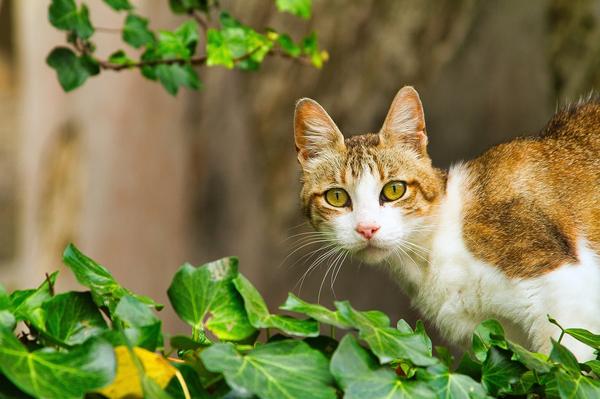Why Is My Cat Swiping at Everyone and What Should I Do?

Is your cat turning into a professional boxer, taking swipes at everyone who dares to cross its path?
Trust me, I feel your pain. It's like they've mastered the art of aggression and we're stuck in the ring.
But fear not! 😺
Because in this blog post, we're going to dive deep into the mysterious whirlpool of our feline friends' behavior.
So, put on your gloves and let's step into the ring to uncover the reasons behind this feisty behavior together.
Let the investigation begin!
What Causes Sudden Aggression in Felines?
Diet and nutritional factors in cat aggression
Now, listen up.
What you put in your cat's food bowl really affects their behavior.
The things they eat can sometimes make them act aggressive.
So be careful about what you feed them!
Other underlying causes of feline aggression
It's not just the food, okay?
There are other things that can make a cat get aggressive.
For example, they might have something called hyperthyroidism or idiopathic aggression (which basically means being aggressive without any clear reason).
These things can also contribute to them acting aggressive.
And guess what?
Other reasons like hunting instincts or certain health issues can also make them more likely to be aggressive.
So, it's not always because of their personality or that other cat from down the street.
Tips for reducing cat aggression
Alright, let's get serious.
If you want to calm down your wild cat, there are a few things you can do.
Firstly, if you're bringing another cat into your cat's territory, you need to be careful!

Your resident cat might see this as a threat, and that's when the claws come out.
But here's some good news:
Getting your cat spayed or neutered can really reduce their aggression.
So maybe it's time for your cat to get a little "snip" if they've been acting badly.
Also, playing with your cat is a great way to relieve stress and redirect their aggressive tendencies.
But please, use appropriate toys instead of flailing your hands around like crazy!
Lastly, try not to change things too much in their environment.
Cats love having a routine, and sudden changes can really upset them.
So keep things consistent and avoid unnecessary tension between your furry friends.
Now, here's the deal...
While vocalizations and body language can indicate aggression in cats, there are specific triggers that may cause their aggressive behavior.
By understanding these triggers, you can effectively respond to aggression and create a harmonious environment for your furry friends.
But what exactly are these triggers?
Let's dive into the fascinating world of feline aggression and explore the different factors that contribute to it:
What Does Aggression in Cats Look Like?
To keep everyone safe, you need to know if your cat is being aggressive.
Here are 11 signs you should watch out for:
- If your cat starts making hissing, growling, or yowling sounds.
- Pay attention to their body language – swiping, a hunched posture, flattened ears, or dilated pupils can all be signs of aggression.
- Cats who haven't had much exposure to strangers might have trouble accepting them.
- Make sure visitors know about your cat's behavior and set boundaries to avoid any problems.
- Sometimes, cats may adopt offensive postures to appear bigger when faced with aggression.
- Defensive postures are used by cats to protect themselves when they feel threatened.
- Swiping is another way cats establish distance from things they see as threats.
- Hissing, growling, raising the fur on their back, and biting are all clear signs of aggression.
- Some cats may become aggressive when they no longer enjoy petting.
- Incorrect sexual imprinting can lead to cats being aggressive towards humans.
- Aggression can be directed towards people, other cats, or animals.
Aggression between household cats often happens because of territorial behavior.
This aggression can sometimes be subtle, with cats showing hostility towards other pets or even people.

Knowing these signs will help you handle aggression calmly and effectively. 😼
But, what causes this aggression in cats and how can you stop it before it escalates?
If you're wondering if there are specific stressors or triggers behind your cat's aggressive behavior, I have some answers for you.
You may be surprised to learn that loud noises and excessive handling can contribute to redirected aggression in cats.
But fear not, by identifying these potential stressors and working with a behaviorist, you can take proactive steps towards resolving this issue...
What Causes Redirected Aggression in Cats?
Redirected aggression in cats is a big problem, trust me. 😾
It's when a cat gets all worked up about something that has nothing to do with you, and instead takes it out on another cat or person.
No one enjoys this kind of situation, so you need to understand what causes it.
One major factor is stress. Things like loud noises and too much handling can really stress cats out and make them lash out.
To prevent this aggressive behavior, you need to find the things that stress your cat and try to minimize them.
Working with a behaviorist can be a great help here.
They can figure out what triggers your cat and come up with ways to get rid of those triggers.
This way, you won't have to deal with repeated incidents of redirected aggression.
But wait, no need to worry!
There's more you can do.
Creating positive associations between your cats is also super important.
Whenever they're together, give them treats and rewards.
This helps them see each other in a better light and reduces chances of aggression.
And if one cat scares the other, separating them and slowly reintroducing them is necessary to address and solve the aggression issue.
So there you go – a few steps you can take to manage redirected aggression in your cats!
And finally, if you're dealing with a situation where your cat is bullying your dog, I understand how frustrating and concerning this can be.
That's why I want to share my insights and solutions in my article Why Is My Cat Bullying My Dog.
Understanding Fear-Induced Aggression in Cats
To effectively address fear-induced aggression in cats, you should have a deep understanding of this concerning behavior.
Whether your cat is hissing, swiping at dogs, or displaying defensive body language, you need to identify the underlying causes and find appropriate solutions.
Fear aggression in cats can arise from various factors, including lack of socialization, genetic predisposition, and improper interactions between humans and cats.
These elements contribute to a cat feeling fearful and mistrustful, which often leads to aggressive behaviors.
One effective way to reduce fear-induced aggression is to provide safe hiding spots or elevated areas where your cat can retreat when they feel threatened. This creates a secure environment where they can regain confidence and alleviate anxiety.
Another important strategy is gradual exposure to unfamiliar stimuli.
Cats are highly sensitive creatures, with keen senses for smells, sounds, and movement.

By introducing new experiences slowly and in a controlled manner, you can help acclimate your cat to these stimuli, making them feel more comfortable and less afraid.
It is worth noting that a cat's past experiences significantly influence their behavior. Cats with limited socialization experience may exhibit aggression when encountering unfamiliar individuals. Addressing and working through these negative experiences can play a critical role in managing fear-induced aggression.
Furthermore, certain types of aggression, such as maternal and territorial aggression, are common in cats.
If you observe these behaviors in your cat, seeking guidance from an animal behaviorist is highly recommended. These professionals possess the expertise needed to assess the situation and provide tailored strategies for managing and reducing aggression.
Ultimately, creating a harmonious environment for both you and your cat requires patience and understanding.
And now, let's delve into another important aspect of understanding your cat's aggression.
We must consider the potential role that physical discomfort or underlying medical conditions may play in triggering aggressive behavior.
You ought to remember that our feline friends can't always communicate their pain to us verbally, but it can manifest as aggression.
So, let me shed some light on how pain-related aggression can impact your cat's behavior and what steps you can take to address it...
Managing Pain-Related Aggression in Cats
To deal with your cat's aggressive behavior caused by pain, here are ten steps you can follow:
- Treat your feline friend with care and gentleness to avoid adding more discomfort.
- Make an appointment for a check-up at the vet's office to detect any underlying medical issues.
- If conditions like liver disease or neurological problems are present, make sure they receive proper treatment.
- Use suitable pain management techniques to tackle arthritis if that's causing your cat's pain.
- If hormonal imbalances are responsible for the aggression, find ways to restore them to balance.
- Be mindful of situations that might provoke pain or unease in your cat and try to prevent them.
- Create a secure and safe environment where your cat feels protected.
- Provide a well-balanced diet and engaging activities to ensure your cat gets the necessary nutrition and mental stimulation.
- Regularly engage in playtime and social interaction to minimize frustration and boredom.
- Seek guidance from a veterinarian or behaviorist who has experience dealing with pain-related aggression in cats.
It's vital to identify the root cause of their aggression quickly and address it appropriately in order to effectively manage pain-related aggression in cats.
Wanna know MORE? Further down the blog post, I'll provide important information about what you should do if your cat experiences sudden aggression. So keep reading to ensure you have all the necessary tools to address this issue effectively.
And now, let's delve into the fascinating world of play aggression in cats... You won't believe what surprises await you...
Preventing and Managing Play Aggression in Cats
To prevent and manage play aggression in your cats, you have to maintain a harmonious environment. Here are some tips that can help you deal with this behavior:
- Give them appropriate toys like feather wands or laser pointers that replicate hunting. This allows them to exercise their predatory instincts without resorting to aggression.
- Pay close attention to their body language during playtime. If their tail starts swishing rapidly or their ears flatten, it might mean they're overstimulated. Take a break and let them calm down.
- Make sure your cats have socialization opportunities and exposure to other cats. This helps them develop proper social skills. Introduce new experiences gradually to avoid fear-based aggression.
- Offer plenty of playtime for your cats. Engaging in interactive play sessions will help release excess energy and decrease the likelihood of aggressive behavior.
- Avoid rough play interactions. Even though kittens often engage in rough play, it's important to discourage behaviors that could lead to aggression later on.
- Be aware of signs of territorial issues. Cat-on-cat chasing can stem from unmet energy needs or attempts to establish dominance. Address these underlying causes of aggression.
- Create a safe space where your cat can retreat if they feel overwhelmed. Provide hiding places, elevated perches, and scratching posts to offer them a sense of security.
By adhering to these instructions, you can create a climate that promotes calm play and minimizes aggressive behavior during your cat's playtime.
Strategies for Minimizing Noise-Induced Aggression in Cats
If your cat has a tendency to become agitated by certain sounds, soundproofing solutions can be of great help.
Cats have an extraordinary sense of hearing, which means they can pick up even the slightest variations in voices and sounds.
Specific frequencies, like the cries of other felines, high-pitched whistles, wailing infants, or squeaky noises, hold the potential to trigger aggression in cats.
To create a more peaceful atmosphere for your furry friend, consider using noise-canceling curtains or white noise machines. These suggestions will minimize the impact these triggering sounds have on sensitive felines, providing them with a calmer environment.
What Should I Do if My Cat Experiences Sudden Aggression?
If your cat starts acting all mean and aggressive, here's what you gotta do:
- Stick to a regular routine so nothing sets off your furry friend.
- Don't punish them, it'll just make things worse.
- Get their little feline butt checked out by the vet to rule out any health issues.
- Hands off when male cats get frisky, they're in their own zone then.
- If your cat is throwing punches, it's time to call in the experts.
- Keep an eye on their behavior and consult with a behaviorist for advice.
- Make sure there's a safe spot for your cat when guests come over.
- Turn those visits into happy times for your kitty.
- Teach your cat that visitors bring good stuff they love.
- Slowly introduce different people based on how your cat reacts.
Solving aggression takes time and understanding on your part, buddy. 😺
Summing it up
Key Takeaways:
- Hyperthyroidism and idiopathic aggression can contribute to aggressive behavior in cats.
- Predatory behaviors and medical conditions can also play a role in aggression.
- Introducing a new cat into a resident cat's territory can be perceived as a threat.
- Spaying and neutering significantly reduce aggression, and play can help reduce stress.
- Changes in the environment can cause tension among cats, so minimizing their impact is best.
- Understanding feline body language is crucial to responding effectively to aggression.
- Swiping is a defensive behavior used by cats to establish distance from perceived threats.
- Aggression in cats can be signaled through various body language cues.
- Working with a behaviorist can help identify and manage redirected aggression.
- Fear aggression in cats requires attention from an animal behaviorist.
- Medical conditions like neurological disease and pain can cause aggression in cats.
- Pay attention to a cat's body language during playtime to prevent overstimulation.
- Certain frequencies of sound can trigger aggression in cats.
- Avoid punishments and seek professional help to address aggression in cats.
- Creating a safe space and providing positive experiences for the cat when visitors come over is crucial.
And that wraps up today's article.
If you wish to read more of my useful articles, I recommend you check out some of these: Why Is My Cat Pooping Under My Bed, Why Does My Cat Like My Husband More Than Me, Why Doesnt My Cat Meow, Stress in Cats, and Why Is My Cat So Desperate for Attention
Talk soon,
-Sarah Davis